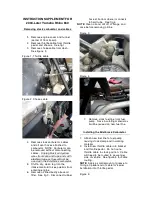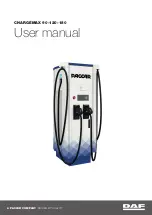
on the Safety Compliance Certification Label (affixed to either the door
hinge pillar, door-latch post, or the door edge that meets the door-latch
post, next to the driver’s seating position), or Tire Label which is located
on the B-Pillar or the edge of the driver’s door. The cold inflation
pressure should never be set lower than the recommended pressure on
the Safety Compliance Certification Label or Tire Label.
When weather temperature changes occur, tire inflation pressures also
change. A 10°F (6°C) temperature drop can cause a corresponding drop
of 1 psi (7 kPa) in inflation pressure. Check your tire pressures
frequently and adjust them to the proper pressure which can be found
on the Safety Compliance Certification Label or Tire Label.
To check the pressure in your tire(s):
1. Make sure the tires are cool, meaning they are not hot from driving
even a mile.
Note:
If you are checking tire pressure when the tire is hot (for
example, driven more than 1 mile [1.6 kilometers]), never bleed or
reduce air pressure. The tires are hot from driving and it is normal for
pressures to increase above recommended cold pressures. A hot tire at
or below recommended cold inflation pressure could be significantly
under-inflated.
Note:
If you have to drive a distance to get air for your tire(s), check
and record the tire pressure first and add the appropriate air pressure
when you get to the pump. It is normal for tires to heat up and the air
pressure inside to go up as you drive.
2. Remove the cap from the valve on one tire, then firmly press the tire
gauge onto the valve and measure the pressure.
3. Add enough air to reach the recommended air pressure.
Note:
If you overfill the tire, release air by pressing on the metal stem in
the center of the valve. Then recheck the pressure with your tire gauge.
4. Replace the valve cap.
5. Repeat this procedure for each tire, including the spare.
Note:
Some spare tires operate at a higher inflation pressure than the
other tires. For T-type mini-spare tires, see the
Dissimilar Spare Tire
and Wheel Assembly Information
section. Store and maintain at 60 psi
(4.15 bar). For full-size and dissimilar spare tires, see
Dissimilar Spare
Tire and Wheel Assembly Information
under
Changing a Road Wheel
in this chapter. Store and maintain at the higher of the front and rear
inflation pressure as shown on the Tire Label.
274
Wheels and Tires
2014 05+ Mustang
(197)
Owners Guide gf, 3rd Printing, January 2014
USA
(fus)
Содержание 2014 MUSTANG
Страница 302: ...5 0L V8 engine Capacities and Specifications 301 2014 05 Mustang 197 Owners Guide gf 3rd Printing January 2014 USA fus ...
Страница 443: ...442 Scheduled Maintenance 2014 05 Mustang 197 Owners Guide gf 3rd Printing January 2014 USA fus ...
Страница 463: ...2014 05 Mustang 197 Owners Guide gf 3rd Printing January 2014 USA fus ...
















































